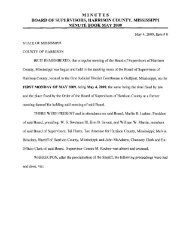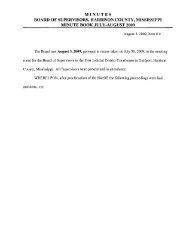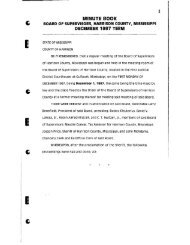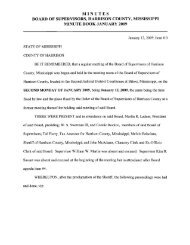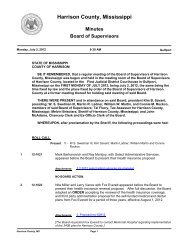- Page 1 and 2:
MINUTES BOARD OF SUPERVISORS, HARRI
- Page 3 and 4:
.. . PROOF OF PUBLICATION STATE OF
- Page 5 and 6:
PJU GLMFSP21 09/10/2009 15:25 Compt
- Page 7 and 8:
HMUUSON COUNTY TAX LEVY SHEET FISCA
- Page 9 and 10:
For HARRlSON COUNlY FIRE DISTRICT a
- Page 11 and 12:
are deserving of recognition for th
- Page 13 and 14:
MINUTES BOARD OF SUPERVISORS, HARRI
- Page 15 and 16:
MINUTES BOARD OF SUPERVISORS, HARRI
- Page 17 and 18:
MINUTES BOARD OF SUPERVISORS, HARRI
- Page 19 and 20:
ACRONYMS USED IN THIS PLAN C&D OAT
- Page 21 and 22:
Hazardous Waste: A product used for
- Page 23 and 24:
HARRISON COUNTY DEBRIS MANAGEMENT T
- Page 25 and 26:
the owner. Long term recovery opera
- Page 27 and 28:
Engineer will be designated the Ass
- Page 29 and 30:
Debris Manager (Daniel Boudreaux, C
- Page 31 and 32:
• Private property adversely affe
- Page 33 and 34: e used to obtain the public's coope
- Page 35 and 36: e provided to the EOC. Based on its
- Page 37 and 38: Private Property Debris Removal: If
- Page 39 and 40: site being used by the County. A di
- Page 41 and 42: • work with the DMC staff to asse
- Page 43 and 44: ENCLOSURES Enclosure 1: Enclosure 2
- Page 45 and 46: Enclosure 2 CRITICAL FACILI1"IES AN
- Page 47 and 48: HARRISON COUNTY DEBRIS MAMAGEMENT O
- Page 49 and 50: UNIFIED SYSTEM OF TRUCK BED VOLUME
- Page 51 and 52: Station #3 Personnel required: •
- Page 53 and 54: Enclosure 6 HARRISON COUNTY DEBRIS
- Page 55 and 56: Enclosure 8 SAMPLE LOAD TICKET DATA
- Page 57 and 58: If yes, list photo log numbers: Gen
- Page 59 and 60: General notes and comments: {includ
- Page 61 and 62: Enclosure 12
- Page 63: FEMA DAP9523A; DISAstER ,ASSISTANCE
- Page 67 and 68: Enclosure 13 FEMA DAP9523.11 DISAST
- Page 70 and 71: Hazardous Stumps A hazardous tree o
- Page 72 and 73: Port-a-johns Each Disposal Site - p
- Page 74 and 75: Name of Insurance Co. _ Insurance P
- Page 76 and 77: areas. Progressive Updates o o o Up
- Page 78 and 79: 4. Remediation plan reviewed by Cou
- Page 80 and 81: Site Re-approval Sites that were ap
- Page 82 and 83: 6. Sites bisected by overhead power
- Page 86 and 87: larger buffer to the seasonal high
- Page 88 and 89: Environmental Checklist for Air Cur
- Page 90 and 91: ENCLOSURE 16 LIST OF PRE-QUALIFIED
- Page 92 and 93: 4.4.3 Chemical Hazards 4.5 Work Zon
- Page 94 and 95: 2.2.2 The Debris Collection Coordin
- Page 96 and 97: off of or expelled by heavy equipme
- Page 98 and 99: heat stroke depends on the victim's
- Page 100 and 101: Natural Hazards in the post disaste
- Page 102 and 103: 4.4 Hazardous Materials Hazards rel
- Page 104 and 105: f.) Ensure that spotters and heavy
- Page 106 and 107: 5.5.2 The presence of human remains
- Page 108 and 109: existing and predictable hazardous
- Page 110 and 111: e.) Keep the generator dry; protect
- Page 112 and 113: • After rinsing thoroughly, dry h
- Page 114 and 115: FactSheet Protect Yourself! Workers
- Page 116 and 117: --~--------QSFlA FactSheet Protect
- Page 118 and 119: • Encourage workers to protect th
- Page 120 and 121: ·······OSHA- FactSheet Prote
- Page 122 and 123: OSHA FactSheet Protecting Workers f
- Page 124 and 125: OSHA FactSheet Flood Cleanup Floodi
- Page 126 and 127: Tips to Remember • Before working
- Page 128 and 129: Tips to Remember For all workers wh
- Page 130 and 131: -----OSHA FactSheet Protect Yoursel
- Page 132 and 133: MINUTES BOARD OF SUPERVISORS, HARRI
- Page 134 and 135:
Sep, 9. 2009 9:49AM LONG BEACH WORK
- Page 136 and 137:
MINUTES BOARD OF SUPERVISORS, HARRI
- Page 138 and 139:
• I. Purpose The purpose ofthis M
- Page 140 and 141:
• assistance, or a combination of
- Page 142 and 143:
• applicable legislation. Include
- Page 144 and 145:
County ofHarrison, State ofMississi
- Page 146 and 147:
NOW THEREFORE, BE IT ORDERED BY THE
- Page 148 and 149:
ORDINANCE NO. 0908HC209 September 1
- Page 150:
Exhibit "A" 32 SroR~ \ \ \ \ \ \ &0
- Page 153 and 154:
MINUTES BOARD OF SUPERVISORS, HARRI
- Page 155 and 156:
MINUTES BOARD OF SUPERVISORS, HARRI
- Page 157 and 158:
MINUTES BOARD OF SUPERVISORS, HARRI
- Page 159 and 160:
MINUTES BOARD OF SUPERVISORS, HARRI
- Page 161 and 162:
MINUTES BOARD OF SUPERVISORS, HARRI
- Page 163 and 164:
MINUTES BOARD OF SUPERVISORS, HARRI
- Page 165 and 166:
. • Quote US K9 Unlimited, Inc. 1
- Page 167 and 168:
MINUTES BOARD OF SUPERVISORS, HARRI
- Page 169 and 170:
I. RECIPIENT NAME AND ADDRESS (Incl
- Page 171 and 172:
PROJECT NUMBER 2009-WS-QX-0040 AWAR
- Page 173 and 174:
Department ofJustice Office ofJusti
- Page 175 and 176:
MINUTES BOARD OF SUPERVISORS, HARRI
- Page 177 and 178:
MINUTES BOARD OF SUPERVISORS, HARRI
- Page 179 and 180:
MINUTES BOARD OF SUPERVISORS, HARRI
- Page 181 and 182:
Mississippi Development Authority R
- Page 183 and 184:
Applicant Harrison County Cash Summ
- Page 185 and 186:
August 26,2009 ARCHITECTS ~ rE rc r
- Page 187 and 188:
fie An AmerIcan Reprographics Compa
- Page 189 and 190:
UPS Consulting I What We Do Page 1
- Page 191 and 192:
UPS Consulting IWhat We Do Page 1 o
- Page 193 and 194:
UPS Consulting I What We Do Page 1
- Page 195 and 196:
UPS Consulting I What We Do Page 1
- Page 197 and 198:
UPS Consulting I What We Do Page 1
- Page 199 and 200:
UPS Consulting I What We Do Page 1
- Page 201 and 202:
UPS Consulting I What We Do Page 1
- Page 203 and 204:
UPS Consulting I What We Do Page 1
- Page 205 and 206:
UPS Consulting IWhat We Do Page 1of
- Page 207 and 208:
....""" ... MEMO DATE: TO: FROM: RE
- Page 209 and 210:
Mississippi Development Authority C
- Page 211 and 212:
Mississippi Development Authority C
- Page 213 and 214:
Eley Guild Hardy Architects PA 1091
- Page 215 and 216:
.h"n".," H. [!co.y, V\/, Taylor" CJ
- Page 217 and 218:
.AIA Document G703" -1992 Continuat
- Page 219 and 220:
A B C D E F G H I WORK COMPLETED TO
- Page 221 and 222:
Document G706 lM - 1994 Contractor'
- Page 223 and 224:
District 1 HARRISON COUNTY CODE ADM
- Page 225 and 226:
MEMO DATE: TO: FROM: RE: August 31,
- Page 227 and 228:
Applicant Harrison County Period Co
- Page 229 and 230:
Mississippi Development Authority C
- Page 231 and 232:
ARCHITECTS PRINCIPALS James H. Eley
- Page 233 and 234:
,,;.AlA Document G703" - 1992 Conti
- Page 235 and 236:
CONDITIONAL WAIVER AND RELEASE UPON
- Page 237 and 238:
Eley Guild Hardy Architects PA 1091
- Page 239 and 240:
August 26, 2009 iLD r·tqR[)'{ ARC
- Page 241 and 242:
~AIA Document G703 - 1992 Continuat
- Page 243 and 244:
PARTIAL RELEASE AND WAIVER OF LIEN
- Page 245 and 246:
IA Document G70G'" -1994 G.ontracto
- Page 247 and 248:
MINUTES BOARD OF SUPERVISORS, HARRI
- Page 249 and 250:
MINUTES BOARD OF SUPERVISORS, HARRI
- Page 251 and 252:
, STATE OF MISSISSIPPI COUNTY OF HA
- Page 253 and 254:
September 14. 2009. Item # 33 Super
- Page 255 and 256:
MINUTES BOARD OF SUPERVISORS, HARRI
- Page 257 and 258:
---~._---~, ~ .._--_._...,. STANLEY
- Page 259 and 260:
STANLEY Access Technologies Stanley
- Page 261 and 262:
STANLEY ACCESS TECHNOLOG'IES SERVIC
- Page 263 and 264:
6. Existing Service Arrangements. I
- Page 265 and 266:
MINUTES BOARD OF SUPERVISORS, HARRI
- Page 267 and 268:
MINUTES BOARD OF SUPERVISORS, HARRI
- Page 269 and 270:
MINUTES BOARD OF SUPERVISORS, HARRI
- Page 271 and 272:
WHEREAS, Shayna has had recordings
- Page 273 and 274:
MINUTES BOARD OF SUPERVISORS, HARRI
- Page 275 and 276:
MINUTES BOARD OF SUPERVISORS, HARRI
- Page 277 and 278:
MINUTES BOARD OF SUPERVISORS, HARRI
- Page 279 and 280:
MINUTES BOARD OF SUPERVISORS, HARRI
- Page 281 and 282:
MINUTES BOARD OF SUPERVISORS, HARRI
- Page 283 and 284:
1 PREPARED BY & RETURN TO: BLACKWEL
- Page 285 and 286:
3 then grantor shall notify the gra
- Page 288 and 289:
WAIVER OF COMPENSATION The undersig
- Page 290 and 291:
MINUTES BOARD OF SUPERVISORS, HARRI
- Page 292 and 293:
MINUTES BOARD OF SUPERVISORS, HARRI
- Page 294 and 295:
MINUTES BOARD OF SUPERVISORS, HARRI
- Page 296:
MINUTES BOARD OF SUPERVISORS, HARRI





